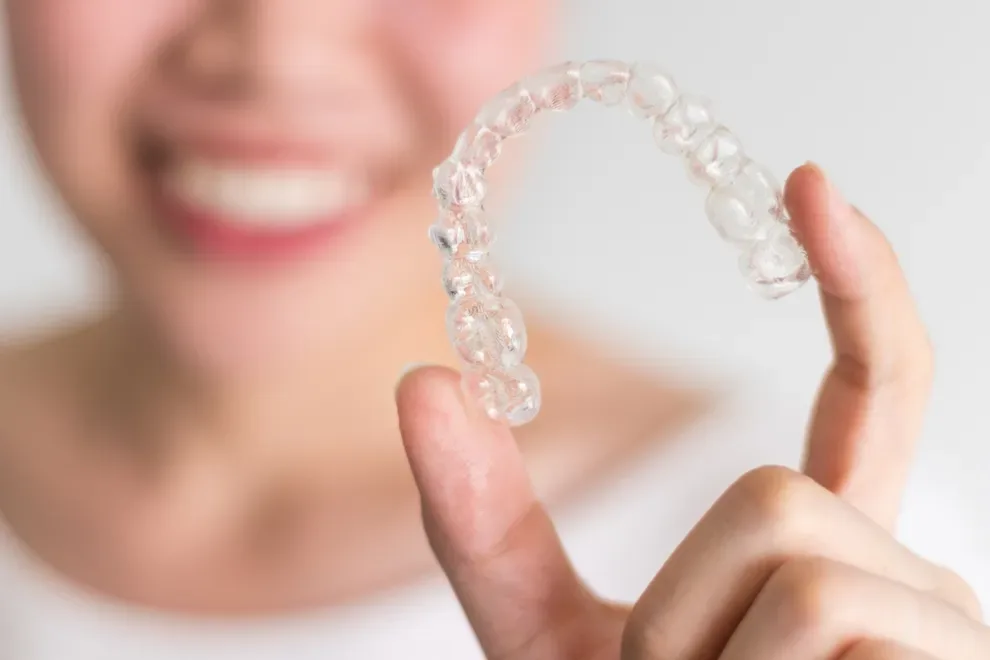At-Home Teeth Straightening: Differences, Costs & Options

Table of Contents
- In-Office Teeth Straightening
- At-Home Aligners
- Benefits of Aligners
- Drawbacks of At-Home Options
- Are At-Home Aligners Right for You?
Do you need to go into a dental professional's office to address your smile? Or will at-home aligners help you get the results you want?
If you're asking yourself these questions, you're certainly not alone.
At-home aligners work quite well for many people, and if you choose this option, you'll likely save both time and money. But potential drawbacks exist, including some involving efficacy.
How Does In-Office Teeth Straightening Work?
Choose a traditional orthodontic experience, and you'll work with a professional in a series of appointments. About once per month, you'll visit the dental professional for a checkup and get a step closer to your perfect smile.
Orthodontists have two main tools they can use to straighten teeth.
Braces: Brackets attach to the front (or back) of your teeth, and they're connected with wires that get shorter during each visit.
Invisalign: Doctors print clear, plastic trays to mold your teeth into a shape you've approved via 3D image. You'll get a new tray with each visit.
Studies suggest Invisalign is just as effective as braces in treating some types of dental problems. If your molars must move back, for example, trays are just as helpful as wires.
But whether you use trays or wires, you'll visit a doctor to move your teeth.
How Do At-Home Aligners Work?
When we're discussing braces you use at home, we're typically talking about invisible braces or aligners. These devices are printed for you by professionals, but you follow a treatment plan at home without ever setting foot in an orthodontist's office.
Every aligner company works a bit differently. But most start treatment with molds and/or images of your teeth. A 3D model of your teeth works as a template for the movement, and trays help to shift your teeth.
You check in with the dental professional periodically via chat or email. Someone is watching your progress, but you may have no formal appointments to keep.
It pays to do your homework before you make a decision, so you can make the choice that's right for your mouth and your overall health.
Benefits of Aligners

Some people enjoy working with a dental professional in a series of hands-on appointments. But there are clear advantages to using a telemedicine approach.
Here are some of those benefits:
Time savings: You don't need to make or keep appointments with at-home aligners. And you don't need to commute to and from a doctor's office.
Efficacy: When researchers conduct studies of teeth aligners, and they include at-home aligners as well as Invisalign, they find similar effectiveness rates to Invisalign alone.
Cost savings: Traditional braces can cost up to $4,937 without insurance. Some aligners can cost up to $8,000 without insurance. By contrast, treatment with at-home aligners like Byte costs $2,099.
Some people also appreciate the opportunity to stay away from a crowded, loud office filled with other people. Improving your smile at home is a much better option when measured against regular office visits.
Drawbacks of At-Home Options
While at-home aligners can be ideal for many people, there are limitations to the care. And buyers must shop carefully.
Major drawbacks involve at-home aligner companies that aren’t reputable. The products may look similar, but some companies create dental plans without the input of an expert, and that can lead to serious health problems, including chipped or missing teeth. Others don't offer robust customer service, so people can't get help when they need it.
Researchers say customers often complain to the Better Business Bureau and similar agencies when they're unhappy. And some experts are worried about the level of complaints they're seeing.
Before you trust your smile to anyone, it pays to thoroughly read reviews. Ask about the company's track record in treating smiles like yours. Ensure your smile is protected by a guarantee in case you're unhappy. And always be willing to keep looking if you're not satisfied.
At-home aligners may also be less than ideal for people with complex smile problems. If your teeth need significant corrections, including severe rotations or tipping help, you might require braces instead of aligners.
Are At-Home Aligners Right for You?
Studies suggest that consumers are equally happy with braces and aligners. They don't complain about one product more than another.
In the end, the choice is up to you. People who choose aligners often enjoy a cheaper price point and a faster treatment timeline.
